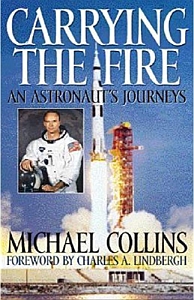Spaced Out Mike
Collins
Mike
CollinsJuly
31, 2019
As the Apollo 11 command module
pilot,
Mike Collins
flew Neil Armstrong and Buzz Aldrin to the moon and back fifty years
ago. Reading his 1974 book,
Carrying
The Fire, I understand him and see a bit of him in me.
Collins
wore an eye-patch over his eye while in orbit around the moon. He did
acrobatics in a T-38 just days before lift-off. He explained Velcro.
And he was first to get into his spacesuit before leaving for the
launch pad.
There are reasons for all of that but I
have to encourage people to read his book.
I will
explain two moments Collins had before lift-off that remind me of me.
You
know the video showing the astronauts walking in a hallway or a gantry
heading for the Saturn V rocket? Each astronaut is carrying their
portable oxygen suitcases. Armstrong is first, then Collins, and then
Aldrin. Collins is hiding a brown paper shopping bag between his white
oxygen suitcase and his spacesuit. At first I couldn't notice it, but
then I couldn't
not
notice it. Billions of dollars of preparations and equipment, plus one
brown paper grocery bag. Collins was carrying a going-away present for
Guenter Wendt, the technician in charge of getting the crew into the
command module. As Neil Armstrong was getting into the spacecraft,
Collins gave a Trout Trophy with a minnow on it to Wendt.
Prior
to launch, laying on their command module couches from left to right
are Armstrong, Aldrin, and Collins. The most critical control in the
room full of controls is the abort handle just past Armstrong's left
knee. A simple 30 degree turn of the handle will fire three solid
rockets above them to yank the command module, the uppermost part of
the Saturn V rocket, up and sailing over to the Atlantic Ocean. Not
exactly a control to bump into unnecessarily, but Collins
noticed “a horrifying thing. A large bulky pocket
has been
added to Neil's left suit leg, and it looks as though if he moves his
leg slightly, it's going to snag on the abort handle. I quickly point
this out to Neil, and he grabs the pocket and pulls it as far over
toward the inside of his thigh as he can, but it still doesn't look too
secure to either one of us. I can see the headlines now 'MOONSHOT FALLS
INTO OCEAN. Mistake by crew, program officials intimate. Last
transmission from Armstrong prior to leaving launch pad reportedly was
'Oops.'”
Music Association: Bob
Seger - Shame On The Moon Johnny Carson's Monologue
Johnny Carson's Monologue
Medaling
and MeddlingJuly
29, 2019
[Ed McMahon:
And now, here's Johnny!]
Thank
you!
Thank you, very much! It's great to be in
Burbank, the only
bank without any interest. And speaking of not having any interest, did
you hear about President Trump --
Do you like how I
tied that in?
Last
week, President Trump spoke in front of a fake Presidential Seal. It
had a two-headed bird, golf clubs instead of arrows, and a wad of cash
instead of an olive branch. No one noticed or had any interest. None of
you have any interest!
All right.
Well,
did you hear
about the preparations for next year's Olympics in Tokyo? They're
making the Olympic medals out of recycled computers and electronics.
Yes.
And
(Johnny's voice cracks) -- there will be a few new
medaling categories:
- plastic
- cracked
iPhone glass, and
- melted down Windows paperclip guys
You
see, it's all about recycling...
How many of you
remember the annoying Windows paperclip assistants? Okay.
How
many of you remember Windows?
How many of you
remember anything without first checking the cell phone?!?
Uh.
Speaking of
meddling,
back in 2016 the Russians tried to hack the election in all 50 states.
Some bills to help prevent future election hacking were stopped by
Senator Mitch McConnell.
Are you booing me or
McConnell?
Kentucky is calling him,
Moscow Mitch.
They've put up billboards. When asked for a comment, McConnell
said, “
Nyet.”
Hey,
you're in a great moon tonight. Did I say mood or moon?
Stick
around and we'll be right back!
Music Association: Doc
Severinsen & the NBC Orchestra - Johnny's Theme Spaced Out
Spaced Out
Moon
StepJuly 20,
2019
50th
Anniversary of Stepping on the MoonNeil
Armstrong got it wrong.
Neil
Armstrong was a fighter pilot who flew seventy-eight combat missions in
Korea with Navy Squadron VF-51. On a September 3, 1951 bombing mission,
the wing of his Panther F9F fighter jet was cut by an anti-aircraft
cable. Armstrong kept a cool head and managed to fly to South Korean
airspace before ejecting. After he graduated from Purdue and while a
reservist at the Glenview Naval Air Station, Armstrong married Janet
Shearon on January 28, 1956 at the First Congregational Church of
Wilmette. They had three children: Eric (Rick), Karen (who died from a
brain tumor), and Mark.
Two months after getting
married,
while a test pilot for NACA (predecessor of NASA) out of Edwards Air
Force Base, Armstrong was co-pilot of a B-29 superfortress which was to
air-drop a D-558 Skyrocket from its wing. While at 30,000 feet, the
number 4 engine stopped. The propeller began to rotate freely and spun
so fast it disintegrated, damaging the number 3 engine. Commander Stan
Butchart and co-pilot Neil Armstrong used just the number 2 engine to
make a slow circling descent and land the B-29 safely.
On
March
16, 1966, Neil Armstrong and David Scott flew on Gemini 8 with a
mission to rendezvous and dock with an uncrewed Agena target vehicle in
Earth orbit. After docking, the combined spacecraft began to roll. Out
of contact with Mission Control, Armstrong tried to compensate with the
Gemini's thrusters* without success. He released the Agena, which
caused Gemini 8 to spin faster. The thrusters only seemed to make the
spin worse. While spinning like a top (technically,
300° per
second, according to Michael Collins), Armstrong reached up and fired
the Reentry Control System (RCS) and turned off the thrusters. A recent
biography based on tape-recorded interviews had Neil Armstrong
saying the thrusters had shorted. It fired when they didn't want it to
fire and didn't fire when they did want it. According to a Boeing
source, damaged wiring caused one of the thrusters to stick in the On
position, or as Collins says in
Carrying
The Fire, “
a continuously firing thruster
caused by a short circuit in the wiring to the thruster.”
Again, Armstrong kept a cool head.
On
July 20, 1969, Neil Armstrong took manual control of Apollo 11's Eagle
lunar module, after seeing they were headed toward boulders the size of
cars. Meanwhile, the computer announced 1202 and 1201 data overflow
alarms due to Buzz Aldrin leaving the docking radar (the Rendezvous
Radar) on during the
landing process.**
Armstrong kept a cool head and
landed on the moon. In recorded interviews Neil Armstrong
said that to him the landing on the moon was the achievement, not
stepping on the moon.
With
all due respect to the late, great Neil Armstrong -- astronaut and hero
-- no, the stepping on the moon was the significant moment.
It
wasn't the first time a vehicle had touched the moon.
Before
the Eagle had landed in the Sea of Tranquility, before Apollo, before
Gemini, before Mercury, and before President Kennedy announced in 1961
the plan to land a man on the moon, the Russians had crashed Luna 2 on
the moon. That was 1959. The U.S. crashed three Ranger probes (4, 6,
& 7) in 1962 and 1964. The Russians crashed more Luna probes
(5, 7,
& 8) in 1965. The U.S. crashed Rangers 8 and 9 in 1965. The
Russians landed Luna 9 in 1966. The U.S. landed Surveyor 1 in 1966 and
Surveyors 3, 5, and 6 in 1967.
Hell, on July 21,
1969, the Russians accidentally crashed Luna 15 on the moon
while Apollo
11 was on the moon!A crewed vehicle
landing on the moon was distinctive. Stepping on the moon was the
achievement.

Music Association: Van Morrison
- Moondance* By thrusters, I mean Gemini's Orbit
Attitude and Maneuvering System (OAMS).
** In the 2007
documentary,
In
The Shadow Of The Moon, Buzz Aldrin says,
“The
landing radar was now beginning to receive signals and being Dr.
Rendezvous, no matter what the checklist said, I was going to leave the
rendezvous radar on and active so if we had to abort, it was on and
working and we could reacquire Mike [Collins]
as soon as possible if we had
to go back up.”Spaced Out
“Minneapolis,
We Have A Problem”July
19, 2019
I'm reading
Carrying
The Fire by Mike Collins. Don't tell me how it ends!

Collins
was a test pilot at Edwards Air Force base. He performed a spacewalk on
Gemini 10. And he commanded the Columbia command module on Apollo 11,
but I'm not at that part yet.
Early on in the book,
he commends Houston as the location for mission control, “
I can't imagine calling from the
moon with, ‘Say, Minneapolis, we have a problem up
here.’”
Collins
is so crystal clear on details of astronaut training and NASA
chronology that it puts all those Apollo documentaries to shame. When I
watch a documentary on any subject I know anything about, I evaluate
them by how many new things I learned, how many things are grossly
oversimplified, and how many things they clearly have no clue about.*
After
describing everything leading up to the launch of Gemini 10, Collins
asks himself the most frequent question, “
How long does it take to train
for a flight?” He then responds on page 197,
“
I
hope you are sufficiently bewildered by the events described so far in
this book that you don't know the answer because I don't either. ”
I guessed his lifetime. He starts with the six months preparing for
Gemini 10, but then added to that the six months preparing as backup
for Gemini 7. He adds all the Basic Grubby Training of orbital
mechanics, jungle training, centrifuge, zero-G airplane rides, and
pressure suit work across the country but primarily in Worchester,
Massachusetts. But omitting all the years as a test pilot would be a
mistake because it taught how to be cool under pressure, memorize
details, report details, and follow up on corrections. He says,
“
... it had
taken me thirty-five years to reach crew quarters at Merritt Island,
Florida” and he felt ready.
Gemini
10 pogo-stickingly launched. But right after the Titan rocket first
stage engines cut out and the second stage started up, the first stage
tank ruptured and blew up. The Gemini 10 spacecraft was undamaged by
the blast. After docking with an Agena spacecraft, they used Agena's
engine to increase Gemini's altitude to a (then) record-breaking 475
miles up. On their way to meet up with a second Agena while preparing
for a stand-in-the-doorway EVA (Extra Vehicular Activity), Houston's
Deke Slayton complained that John Young and Mike Collins were too
quiet. Houston wanted to talk baseball while Collins was trying to work
through a 131 step EVA checklist.
Did Houston want
to know about
the knee pain Collin's had endured? Or the two pictures of voluptuous,
beautiful women someone had secretly affixed to the Gemini 10
sunshades?!?
After a complex, second EVA, Collins
took a moment
to see the superbright world moving by every ninety minutes without
doom or gloom, only optimism. That's Collins, the Michael Palin of
astronauts.
Both are optimistic, ex-smokers turned
runners, writing with matter-of-fact ease.
Music Association: Sinatra - Fly
Me To The Moon*
A show purporting to explain why the Beatles broke up was so laughably
sloppy on information, I was surprised they got Paul's name right.
 Music
Videos
Music
Videos Landmine
Hopscotch
Landmine
Hopscotch Superman
Superman Impact
Investing
Impact
Investing Holiday
Gifs of Cats and Kittens Part 1
Part 2
Part
3 Part
4 Part
5
Holiday
Gifs of Cats and Kittens Part 1
Part 2
Part
3 Part
4 Part
5

 Southdale
Hennepin Library Edina
Library
Southdale
Hennepin Library Edina
Library  Wonder
Woman
Wonder
Woman Food
Fraud
Food
Fraud 














